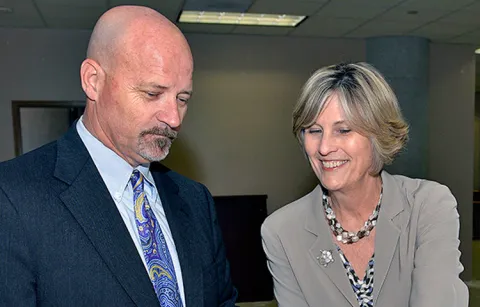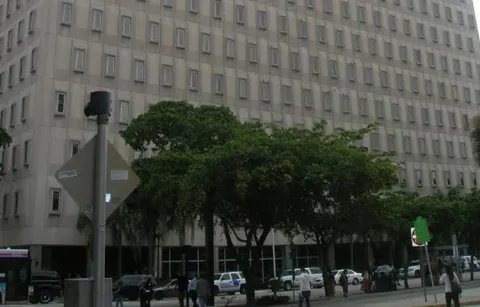
Steven Larimore, clerk of the U.S. District Court for the Southern District of Florida, and Katherine Gould Feldman, clerk of the U.S. Bankruptcy Court for the Southern District of Florida
In a space-cutting move that will save the judiciary more than $1 million a year in rent and security costs, the federal bankruptcy court in Miami is being moved into a nearby district court building.
The relocation, which involves three buildings, is among the most ambitious to date in a national program to reduce federal courthouse space and relinquish unused capacity back to the General Services Administration. Necessary renovations are underway, and the move should be completed by autumn, according to court officials.
“It’s been surprisingly smooth. We had the idea, and eight months later it was approved,” said Steven Larimore, Clerk of the U.S. District Court for the Southern District of Florida. “Our bench was really very receptive. They saw it as the right thing to do in the current fiscal climate.”
The biggest savings involves the Claude Pepper Federal Building, where the bankruptcy court will vacate 31,000 square feet, including three bankruptcy courtrooms and the clerk’s office. That will save about $818,000 annually in rent and security costs.
Bankruptcy operations will be moved a third of a mile to the C. Clyde Atkins U.S. Courthouse, a 1970s-era building that currently houses most of the district court’s Miami-based magistrate judges.
To accommodate the bankruptcy court, two magistrate judges will move from Atkins to a third building, the James Lawrence King Federal Justice Building. As part of the relocation, the Southern District of Florida also will relinquish a vacant jury assembly area at the King Building. That will save an additional $300,000 annually. Total project savings are estimated at $1.1 million annually.
Reducing space and rent is among the Judiciary’s top cost-containment objectives. Federal courts pay $1 billion each year for courthouses and offices—even after a decade-long rent-reduction effort has cut projected costs about $400 million annually. The Judicial Conference of the United States has directed the 12 regional circuits to reduce total space three percent by September 2018.
Larimore said the Miami project was conceived in late 2012, as a result of ongoing discussions between him, Bankruptcy Court Clerk Katherine Gould Feldman, and Chief Probation Officer Reginald D. Michael, on ways to cut all costs.

The U.S. Bankruptcy Court in Miami will be moving out of the Claude Pepper Federal Building, above, relinquishing 31,000 square feet to the General Services Administration.
Each court had something to gain from the transaction. In light of new Judicial Conference space policies, the District Court substantially reevaluated its long-term space needs in Miami after the 14-story Wilkie D. Ferguson Jr. U.S. Courthouse opened next door to the Atkins building. Both courts had cut staff in recent years, further opening space, and Feldman said the Pepper building, where the bankruptcy court operates, had substandard chambers and courtrooms and ongoing building maintenance issues.
Importantly, the two clerks gained full buy-in from the Southern District of Florida’s two chief judges, Federico A. Moreno of the U.S. District Court, and Paul G. Hyman Jr., of the U.S. Bankruptcy Court.
Under a national incentive program administered by the Administrative Office of the U.S. Courts, the district and bankruptcy courts will receive a one-time payment of approximately $800,000 for relinquishing the space—the equivalent of one year’s rent savings. Because of its size, the payment will be spread over two fiscal years.
One key to the proposal’s success has been a climate of collaboration established between the two courts, and the district’s probation office, which smoothed discussions over how to merge space. That collaboration includes an increased sharing of administrative functions.
“It starts with attitude. If you want to get it done, you will find a way to get it done,” said Feldman. “I think it’s why we were able to accomplish so much, in such a short period, with so much support.”
Subscribe to News Updates
Subscribe to be notified when the news section is updated.
